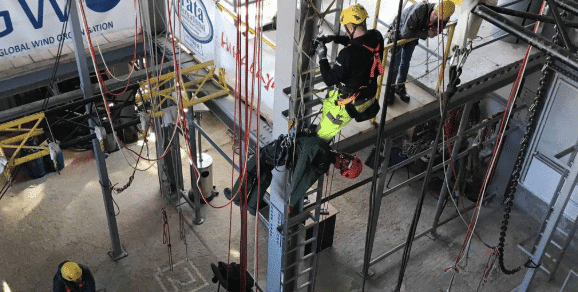Working at Height is statistically one of the most perilous workplace activities. According to a report from the Health and Safety Executive in the UK in 2019/2020 111 workers suffered fatal injuries and 29 of these were caused by falls from height.
But, working at height remains an unavoidable activity in many sectors including the fire service, police, armed forces, construction, offshore, utilities, transport and agriculture, plus countless more. Whether that is working on-site at a highways construction or carrying out daily maintenance duties on a wind turbine, sometimes it is necessary to work at height and it, therefore, becomes a matter of assessing and managing the risk.
Thankfully, many of these industries take a very proactive approach to working at height training and there is also a growing number of dedicated specialist training companies offering courses.
If you have teams that might be expected to perform duties at height, you have a duty to make sure that all staff are trained to a reasonable level of competence, to minimise the risk of serious injury.
Working at Height – The Rules
Within the UK, in respect of competence, The Work at Height Regulations 2005 state:
“Every employer shall ensure that no person engages in any activity, including organisation, planning and supervision, in relation to work at height or work equipment for use in such work unless he is competent to do so or, if being trained, is being supervised by a competent person.”
Similar regulations are in place across the world, for good reason. Training competence is the best way to reduce the risk of accidents occurring in the first place, and perhaps more importantly, give teams the skills they need to rescue someone quickly in the event of an accident.
Why the rules are important!
The speed of rescue is extremely important when working at height. For obvious reasons, when working at height, workers will wear a fall arrest harness. This is designed to prevent a fatal fall from height. However, if someone falls unconscious when suspended, it then becomes vital that they are rescued quickly and placed into a horizontal position to prevent Suspension Trauma (also known as Orthostatic Intolerance or Harness Hang Syndrome). We discuss this in more detail in another blog here
There are many specialist technical rescue companies who can offer working at height rescue training and one of the best ways to make sure that the training they offer is suitable is to check their credentials.
Training with the experts
IRATA (International Rope Access Trade Association) is widely recognised as the world’s leading authority on industrial rope access and offers its members extensive advice on all matters of health and safety. With more than 570 member companies around the world, IRATA has accredited the training of more than 130,000 rope access technicians.
IRATA set membership requirements for anyone wishing to join. This gives companies performing industrial rope access a framework in which to define, demonstrate, and develop the management of a rope access system, and the standards specified must be demonstrated at operational and/or training site locations. This is reassuring for those using IRATA registered members to deliver training to their teams as it ensures that a high level of safety and competence will be maintained, and the skills acquired will be safe and relevant.
Ruth Lee Ltd are registered Associate Members of IRATA
In 2020, after several years developing products for the Working at Height and Rope Access sectors, Ruth Lee Ltd took the decision to join IRATA as Associate Members.
At all times, we have a commitment to helping teams to create the most realistic training by providing suitable ‘casualties’ which can be used in all manner of rope rescue training without risking a volunteer or colleague.
Our Working at Height manikin is used by countless rope rescue teams around the world and mentioned specifically by GWO (Global Wind Organisation) during the pandemic. You can read about their guidance in our blog.
Our Working at Height manikin is designed to sit correctly in a rescue harness and act as an ‘unconscious casualty’ providing an accurate challenge for teams when creating strategies to rescue someone who has been injured or fallen ill whilst suspended. It was developed with assistance from experts in the rope access industry to ensure that it performs correctly in rescue training scenarios.
As world-leading experts in rope access safety, we are pleased that IRATA refer to the use of manikins in the IRATA membership requirements where it states:
“Manikins of at least 70kg shall be available for rescue exercises;”
Our Working at Height manikin is available in range of weights, including the specified 70kg, and this model also includes a NATO Stock number, given the rise in demand for the manikin across military organisations.
Our range of manikins are sold worldwide through a network of distributors and we would be happy to connect you to the stockist closest to your location. Likewise, if you would like to discuss your training requirements or find out more about our range, call us on 01490 413 282 and we be pleased to help find your ideal training partner.
By training correctly, your organisation can help to reduce the risk to those who work at height.
